Strategies to improve English vocabulary teaching a literature review
Having a good command of English vocabulary plays an important role in
second language acquisition because without sufficient vocabulary learners
cannot understand English speakers or express their own ideas in English.
This study conducted a literature review about the necessity to apply some
effective strategies to improve learners‟ English vocabulary instruction. The
results indicated that it is advisable for teachers to use different vocabulary
teaching techniques i.e. explicit, implicit and independent vocabulary
teaching. Based on three approaches, some pedagogical implications for
vocabulary development are put forward as resourceful references for
teachers of English to exploit effective vocabulary teaching opportunities
through different vocabulary teaching strategies.
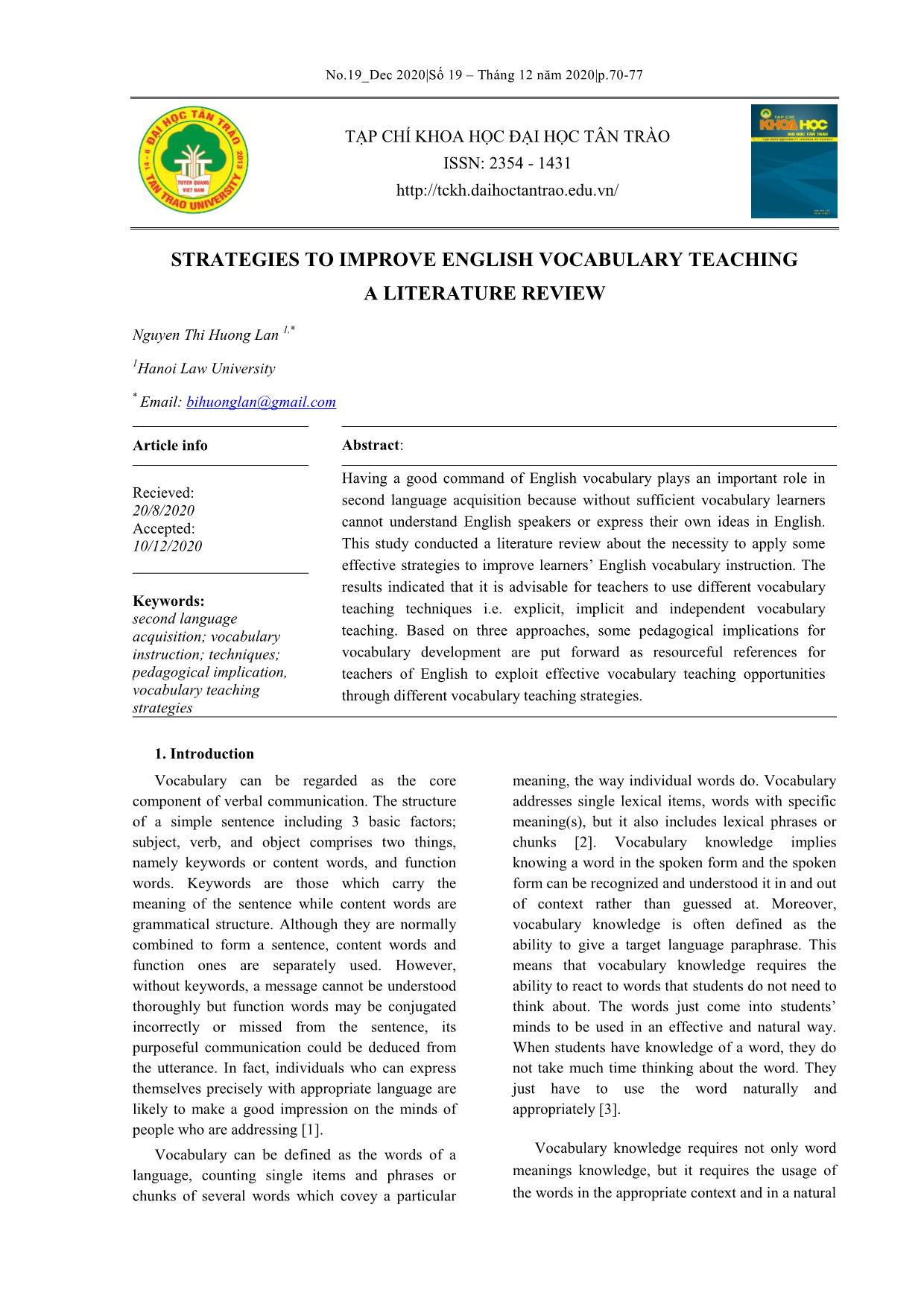
Trang 1
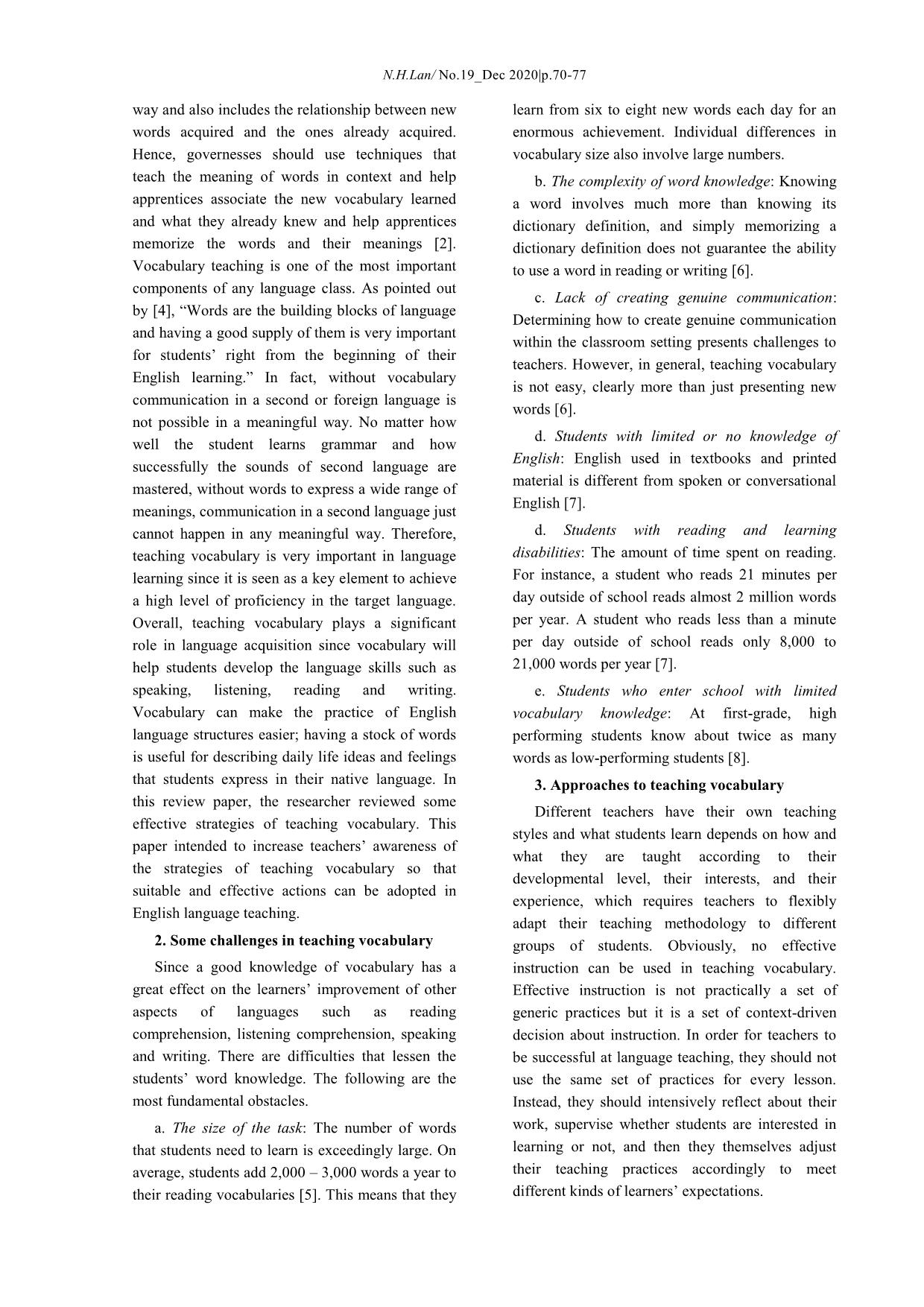
Trang 2
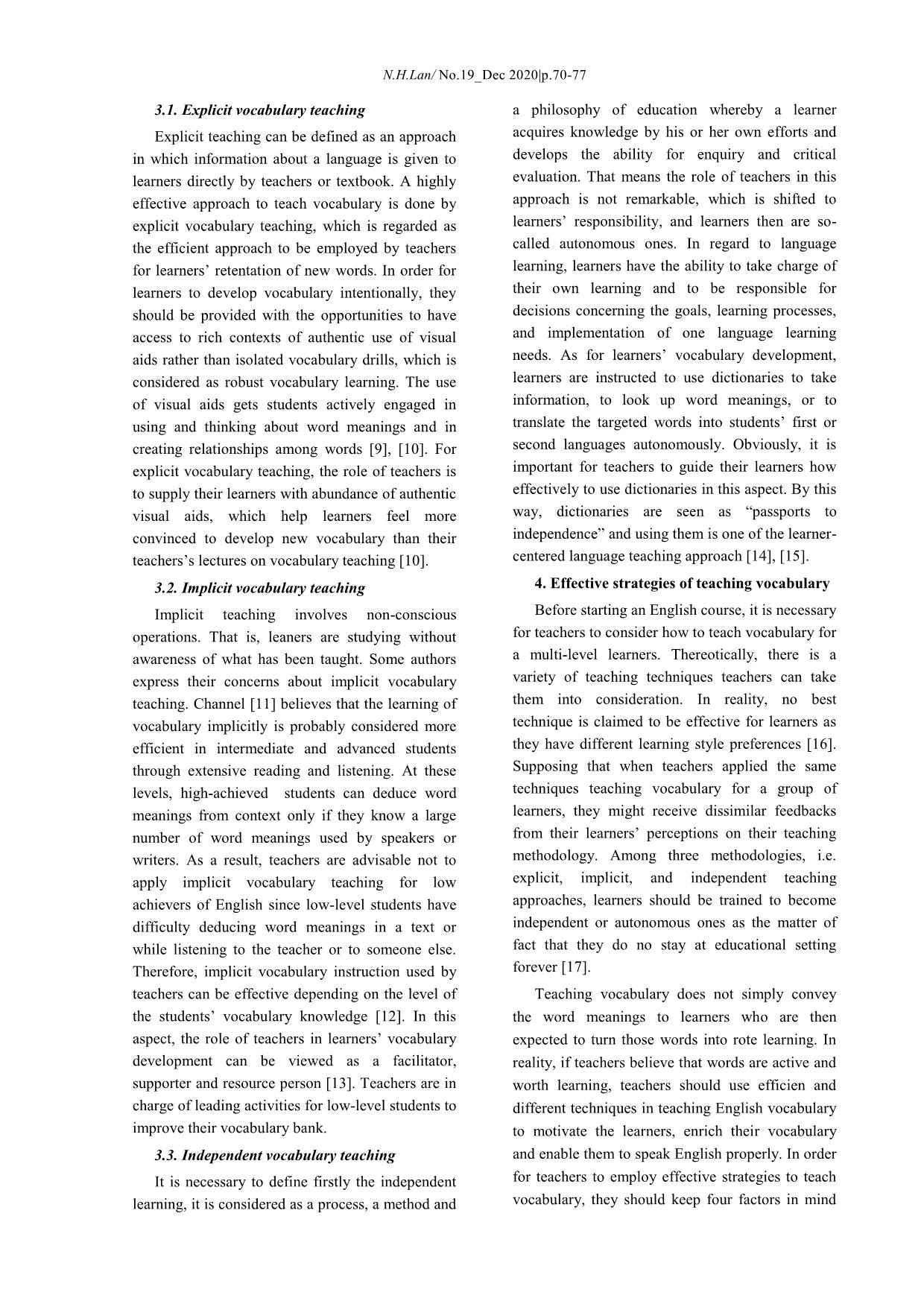
Trang 3
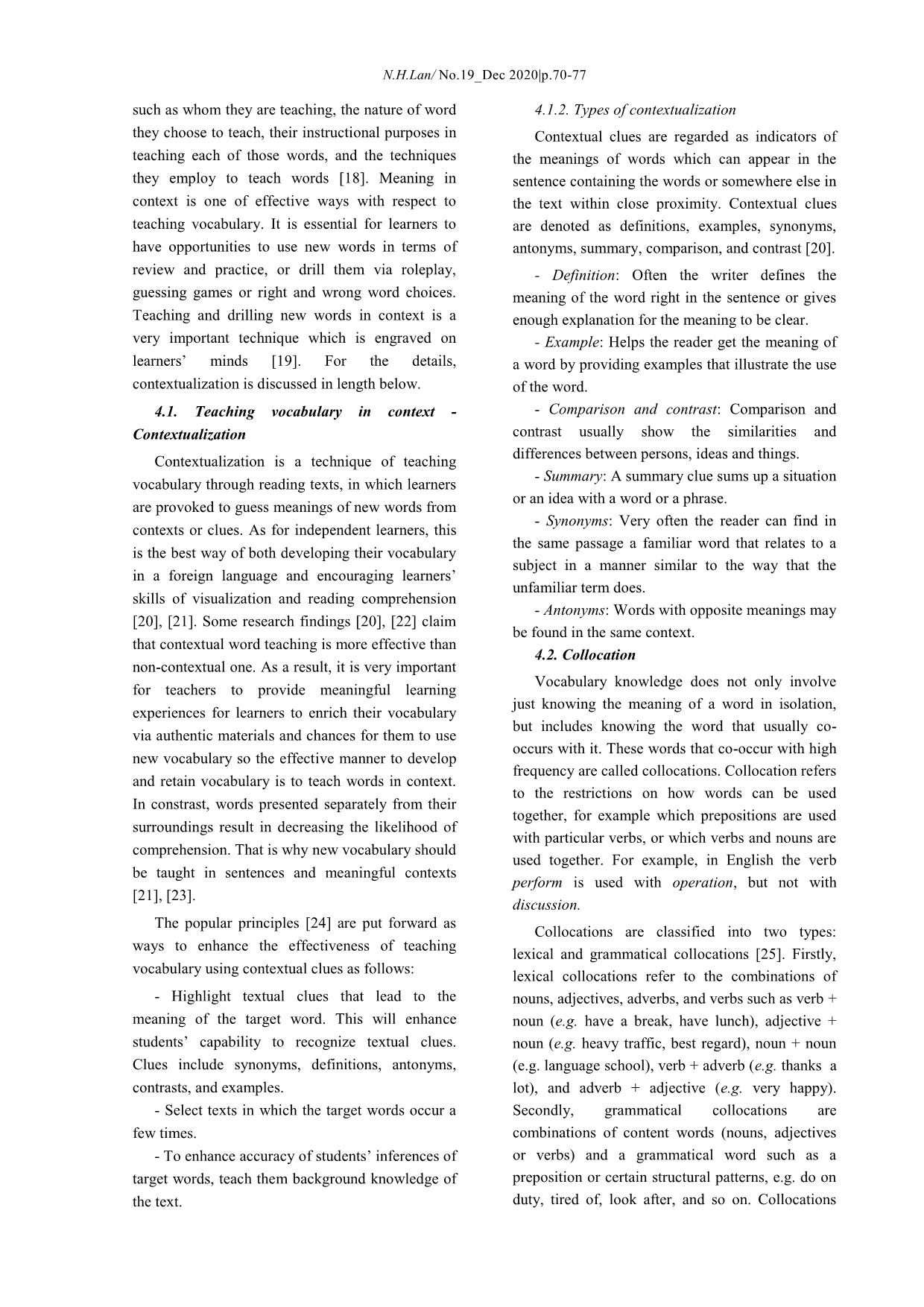
Trang 4
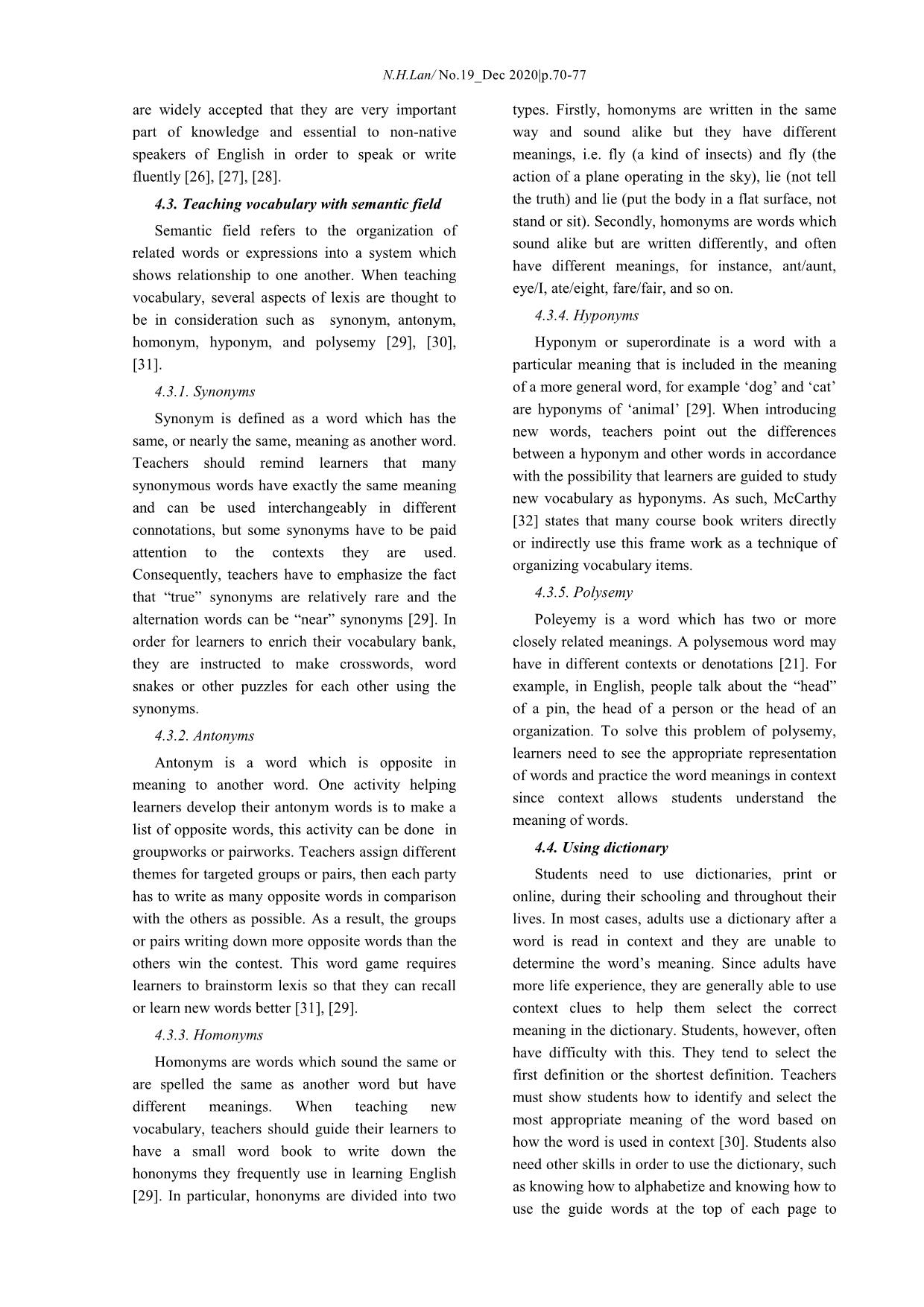
Trang 5

Trang 6
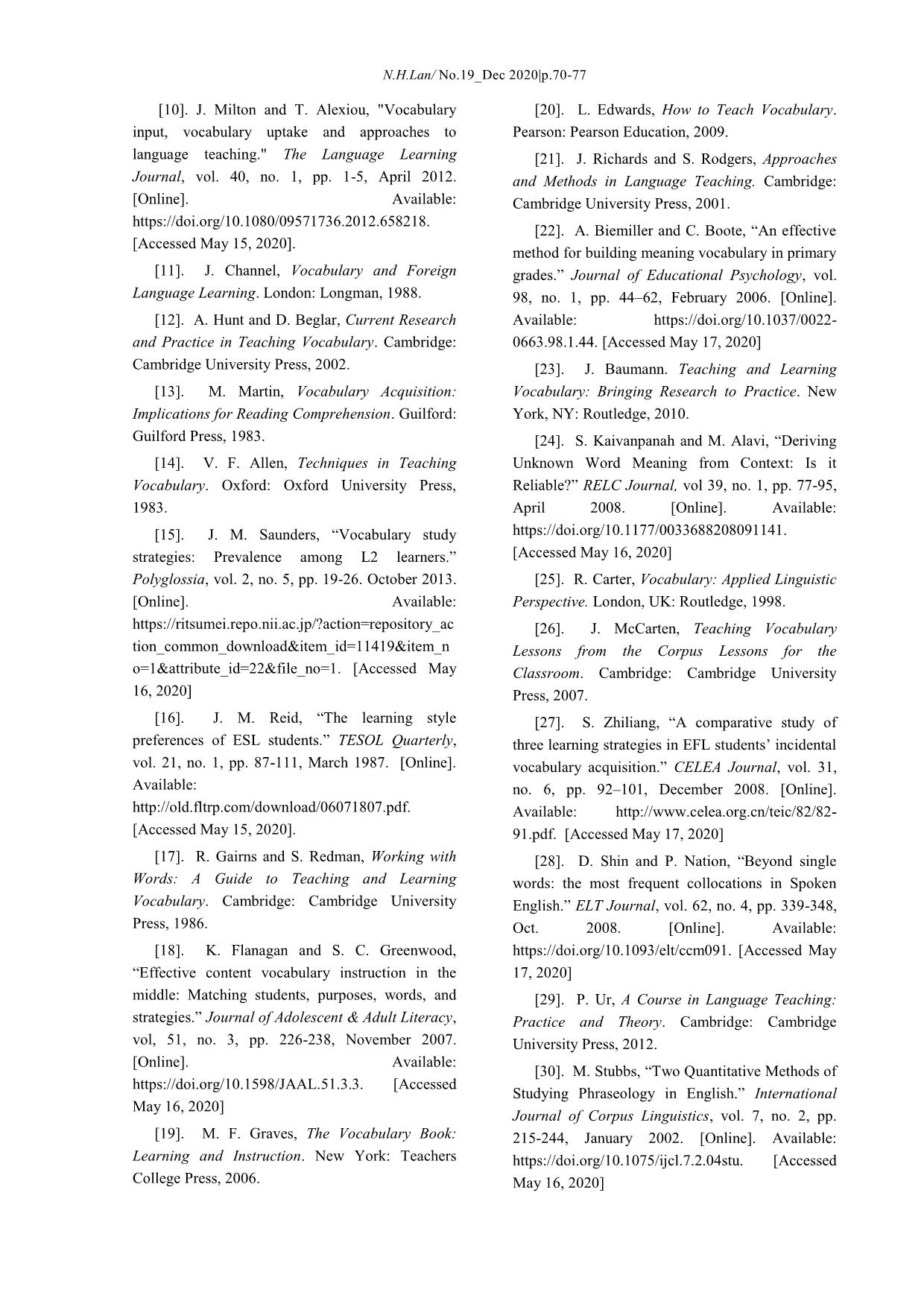
Trang 7
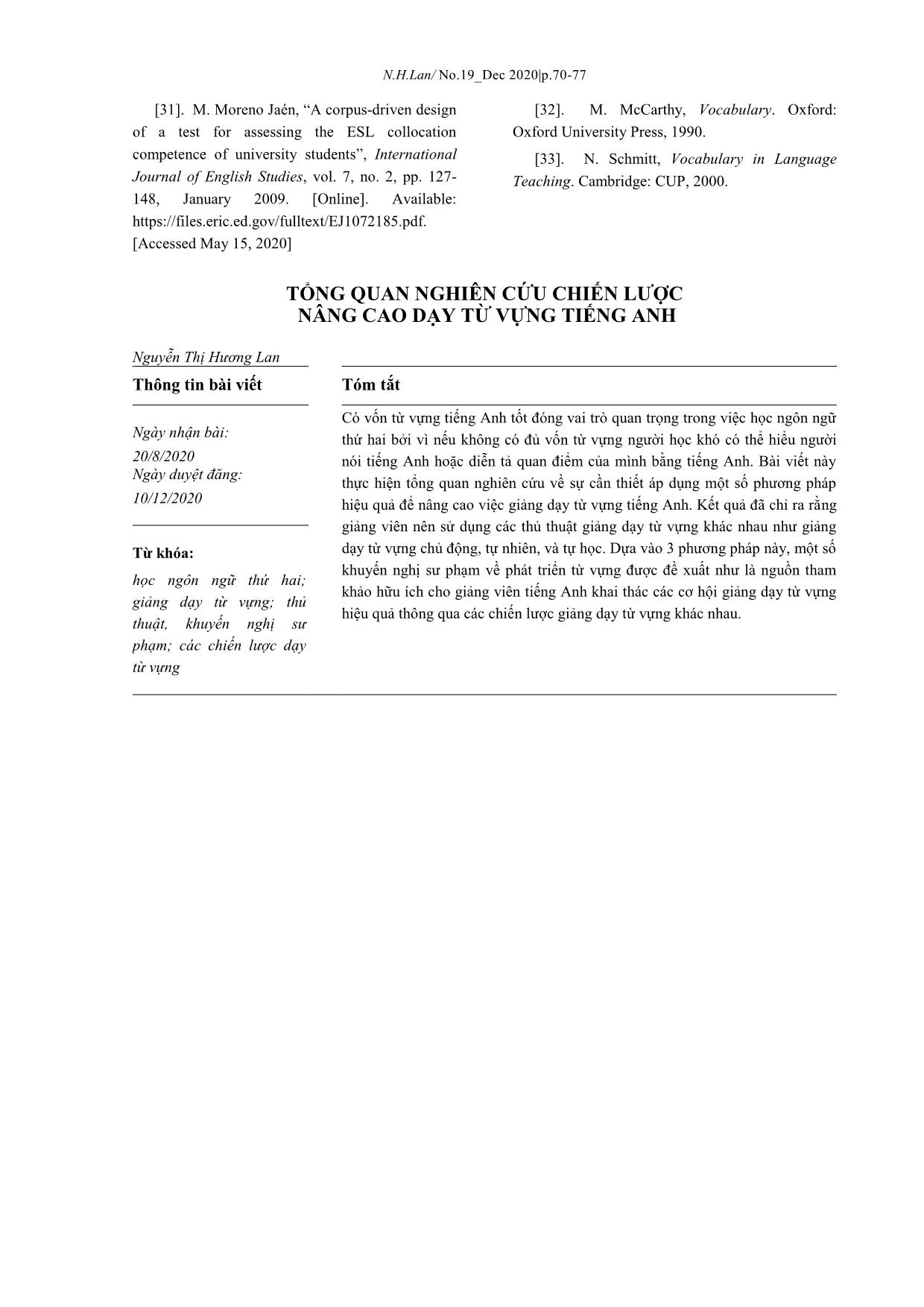
Trang 8
Tóm tắt nội dung tài liệu: Strategies to improve English vocabulary teaching a literature review
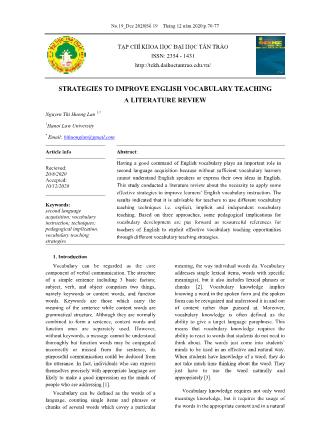
No.19_Dec 2020|Số 19 – Tháng 12 năm 2020|p.70-77 TẠP CHÍ KHOA HỌC ĐẠI HỌC TÂN TRÀO ISSN: 2354 - 1431 STRATEGIES TO IMPROVE ENGLISH VOCABULARY TEACHING A LITERATURE REVIEW Nguyen Thi Huong Lan 1,* 1 Hanoi Law University * Email: bihuonglan@gmail.com Article info Abstract: Recieved: 20/8/2020 Accepted: 10/12/2020 Having a good command of English vocabulary plays an important role in second language acquisition because without sufficient vocabulary learners cannot understand English speakers or express their own ideas in English. This study conducted a literature review about the necessity to apply some effective strategies to improve learners‟ English vocabulary instruction. The results indicated that it is advisable for teachers to use different vocabulary teaching techniques i.e. explicit, implicit and independent vocabulary teaching. Based on three approaches, some pedagogical implications for vocabulary development are put forward as resourceful references for teachers of English to exploit effective vocabulary teaching opportunities through different vocabulary teaching strategies. Keywords: second language acquisition; vocabulary instruction; techniques; pedagogical implication, vocabulary teaching strategies 1. Introduction Vocabulary can be regarded as the core component of verbal communication. The structure of a simple sentence including 3 basic factors; subject, verb, and object comprises two things, namely keywords or content words, and function words. Keywords are those which carry the meaning of the sentence while content words are grammatical structure. Although they are normally combined to form a sentence, content words and function ones are separately used. However, without keywords, a message cannot be understood thoroughly but function words may be conjugated incorrectly or missed from the sentence, its purposeful communication could be deduced from the utterance. In fact, individuals who can express themselves precisely with appropriate language are likely to make a good impression on the minds of people who are addressing [1]. Vocabulary can be defined as the words of a language, counting single items and phrases or chunks of several words which covey a particular meaning, the way individual words do. Vocabulary addresses single lexical items, words with specific meaning(s), but it also includes lexical phrases or chunks [2]. Vocabulary knowledge implies knowing a word in the spoken form and the spoken form can be recognized and understood it in and out of context rather than guessed at. Moreover, vocabulary knowledge is often defined as the ability to give a target language paraphrase. This means that vocabulary knowledge requires the ability to react to words that students do not need to think about. The words just come into students‟ minds to be used in an effective and natural way. When students have knowledge of a word, they do not take much time thinking about the word. They just have to use the word naturally and appropriately [3]. Vocabulary knowledge requires not only word meanings knowledge, but it requires the usage of the words in the appropriate context and in a natural N.H.Lan/ No.19_Dec 2020|p.70-77 way and also includes the relationship between new words acquired and the ones already acquired. Hence, governesses should use techniques that teach the meaning of words in context and help apprentices associate the new vocabulary learned and what they already knew and help apprentices memorize the words and their meanings [2]. Vocabulary teaching is one of the most important components of any language class. As pointed out by [4], “Words are the building blocks of language and having a good supply of them is very important for students‟ right from the beginning of their English learning.” In fact, without vocabulary communication in a second or foreign language is not possible in a meaningful way. No matter how well the student learns grammar and how successfully the sounds of second language are mastered, without words to express a wide range of meanings, communication in a second language just cannot happen in any meaningful way. Therefore, teaching vocabulary is very important in language learning since it is seen as a key element to achieve a high level of proficiency in the target language. Overall, teaching vocabulary plays a significant role in language acquisition since vocabulary will help students develop the language skills such as speaking, listening, reading and writing. Vocabulary can make the practice of English language structures easier; having a stock of words is useful for describing daily life ideas and feelings that students express in their native language. In this review paper, the researcher reviewed some effective strategies of teaching vocabulary. This paper intended to increase teachers‟ awareness of the strategies of teaching vocabulary so that suitable and effective actions can be adopted in English language teaching. 2. Some challenges in teaching vocabulary Since a good knowledge of vocabulary has a great effect on the learners‟ improvement of other aspects of languages such as reading comprehension, listening comprehension, speaking and writing. There are difficulties that lessen the students‟ word knowledge. The following are the most fundamental obstacles. a. The size of the task: The number of words that students need to learn is exceedingly large. On average, students add 2,000 – 3,000 words a year to their reading vocabularies [5]. This means that they learn from six to eight new words each day for an enormous achievement. Individual differences in vocabulary size also involve large numbers. b. The complexity of word knowledge: Knowing a word involves much more tha ... peak or write fluently [26], [27], [28]. 4.3. Teaching vocabulary with semantic field Semantic field refers to the organization of related words or expressions into a system which shows relationship to one another. When teaching vocabulary, several aspects of lexis are thought to be in consideration such as synonym, antonym, homonym, hyponym, and polysemy [29], [30], [31]. 4.3.1. Synonyms Synonym is defined as a word which has the same, or nearly the same, meaning as another word. Teachers should remind learners that many synonymous words have exactly the same meaning and can be used interchangeably in different connotations, but some synonyms have to be paid attention to the contexts they are used. Consequently, teachers have to emphasize the fact that “true” synonyms are relatively rare and the alternation words can be “near” synonyms [29]. In order for learners to enrich their vocabulary bank, they are instructed to make crosswords, word snakes or other puzzles for each other using the synonyms. 4.3.2. Antonyms Antonym is a word which is opposite in meaning to another word. One activity helping learners develop their antonym words is to make a list of opposite words, this activity can be done in groupworks or pairworks. Teachers assign different themes for targeted groups or pairs, then each party has to write as many opposite words in comparison with the others as possible. As a result, the groups or pairs writing down more opposite words than the others win the contest. This word game requires learners to brainstorm lexis so that they can recall or learn new words better [31], [29]. 4.3.3. Homonyms Homonyms are words which sound the same or are spelled the same as another word but have different meanings. When teaching new vocabulary, teachers should guide their learners to have a small word book to write down the hononyms they frequently use in learning English [29]. In particular, hononyms are divided into two types. Firstly, homonyms are written in the same way and sound alike but they have different meanings, i.e. fly (a kind of insects) and fly (the action of a plane operating in the sky), lie (not tell the truth) and lie (put the body in a flat surface, not stand or sit). Secondly, homonyms are words which sound alike but are written differently, and often have different meanings, for instance, ant/aunt, eye/I, ate/eight, fare/fair, and so on. 4.3.4. Hyponyms Hyponym or superordinate is a word with a particular meaning that is included in the meaning of a more general word, for example „dog‟ and „cat‟ are hyponyms of „animal‟ [29]. When introducing new words, teachers point out the differences between a hyponym and other words in accordance with the possibility that learners are guided to study new vocabulary as hyponyms. As such, McCarthy [32] states that many course book writers directly or indirectly use this frame work as a technique of organizing vocabulary items. 4.3.5. Polysemy Poleyemy is a word which has two or more closely related meanings. A polysemous word may have in different contexts or denotations [21]. For example, in English, people talk about the “head” of a pin, the head of a person or the head of an organization. To solve this problem of polysemy, learners need to see the appropriate representation of words and practice the word meanings in context since context allows students understand the meaning of words. 4.4. Using dictionary Students need to use dictionaries, print or online, during their schooling and throughout their lives. In most cases, adults use a dictionary after a word is read in context and they are unable to determine the word‟s meaning. Since adults have more life experience, they are generally able to use context clues to help them select the correct meaning in the dictionary. Students, however, often have difficulty with this. They tend to select the first definition or the shortest definition. Teachers must show students how to identify and select the most appropriate meaning of the word based on how the word is used in context [30]. Students also need other skills in order to use the dictionary, such as knowing how to alphabetize and knowing how to use the guide words at the top of each page to N.H.Lan/ No.19_Dec 2020|p.70-77 locate specific words. To help students learn how to select the appropriate meaning in the dictionary, teachers can use the following steps [19]. Similar to other strategies in this book, the teacher models this process approach to solving words, and students will internalize it with more practice. - Read the sentence containing the unknown word. - Before looking in the dictionary, think aloud and guess the meaning of the word based on the clues in and around the word. - Explain that many words have several meanings and then read all of the dictionary‟s definitions for that word. - Decide which definition makes sense within the context of the text being read. - If the meaning is still unknown, provide further discussion about the context and look at word parts. 4.5. Vocabulary network The notion of vocabulary network or so-called word web, word map, mind map, and word association explains that beyond sameness, oppositeness and inclusion of meanings of words, there is a complex interconnection or network among group of words. In other word, vocabulary network can be defined that the semantic relationship in relation with synonym and antonym tends to simplify the complex nature of the mental lexicon [32]. Similarly, Schmitt [33] confirms that words are not stored in mind in isolated pattern but in an organized and systematic manner. That organization is suitably explained as association or network. Grasping this organizational principles, teachers are supposed to change the curriculum, taking advantages of the task-based language learning approach to help learners to get the best achievement of vocabulary network technique which is believed to function as a convincing framework of organizing lexical items; the scholars‟ idea ensures that vocabulary can be taught better through vocabulary network. 5. Conclusion Vocabulary which is considered as the most important component of communicative competence conveys messages in conversations. Quite different from function words, vocabulary supports speakers to exchange what they want to communicate in a dialogue. Of the 4-micro English skills, i.e. listening, speaking, reading, and writing, learners cannot be successful in second language acquisition without a good command of lexical English. In terms of teaching vocabulary, teachers should not only understand the students‟ difficulties of word study but also use some useful strategies and methods. This review of literature examined the strategies of teaching vocabulary with the hope that the research findings contribute to the improvement of the strategies of vocabulary instruction in English language teaching. REFERENCES [1]. A. Kusnierek, “The role of music and songs in teaching English vocabulary to students.” World Scientific News, vol. 43, no. 1, pp. 1-55, July 2016. [Online]. Available: content/uploads/2015/10/WSN-431-2016-1-55.pdf. [Accessed May 15, 2020]. [2]. E. Jezek, The lexicon: An introduction. Oxford, UK: Oxford University Press, 2016. [3]. P. Nation, Learning Vocabulary in another Language. Cambridge: CUP, 2001. [4]. J. Harmer, The Practice of English Language Teaching. London: Longman, 1992. [5]. I. Beck, M. McKeown and L. Kucan, Bringing Words to life: Robust Vocabulary Instruction. New York, NY: Guilford Press, 2002. [6]. C. Chaudron, "Vocabulary Elaboration in Teachers' Speech to L2 Learners." Studies in Second Language Acquisition, vol. 4, no. 2, pp. 170-180, 1982. [Online]. Available: www.jstor.org/stable/44487233. [Accessed May 10, 2020]. [7]. J. Crisitina and D. Houston, Second language Vocabulary Acquisition. Cambridge: Cambridge University Press, 2010. [8]. B. Hart and T. Risley, Meaningful differences. Baltimore, MD: Paul H. Brookes Publishing Co, 1995. [9]. M. E. Curtis and A. M. Longo, “Teaching vocabulary to adolescents to improve comprehension.” Reading Online, vol. 5, no. 4, pp. 1-32, November 2001. [Online]. Available: _ReadingOnlineArticle.pdf. [Accessed May 15, 2020]. N.H.Lan/ No.19_Dec 2020|p.70-77 [10]. J. Milton and T. Alexiou, "Vocabulary input, vocabulary uptake and approaches to language teaching." The Language Learning Journal, vol. 40, no. 1, pp. 1-5, April 2012. [Online]. Available: https://doi.org/10.1080/09571736.2012.658218. [Accessed May 15, 2020]. [11]. J. Channel, Vocabulary and Foreign Language Learning. London: Longman, 1988. [12]. A. Hunt and D. Beglar, Current Research and Practice in Teaching Vocabulary. Cambridge: Cambridge University Press, 2002. [13]. M. Martin, Vocabulary Acquisition: Implications for Reading Comprehension. Guilford: Guilford Press, 1983. [14]. V. F. Allen, Techniques in Teaching Vocabulary. Oxford: Oxford University Press, 1983. [15]. J. M. Saunders, “Vocabulary study strategies: Prevalence among L2 learners.” Polyglossia, vol. 2, no. 5, pp. 19-26. October 2013. [Online]. Available: https://ritsumei.repo.nii.ac.jp/?action=repository_ac tion_common_download&item_id=11419&item_n o=1&attribute_id=22&file_no=1. [Accessed May 16, 2020] [16]. J. M. Reid, “The learning style preferences of ESL students.” TESOL Quarterly, vol. 21, no. 1, pp. 87-111, March 1987. [Online]. Available: [Accessed May 15, 2020]. [17]. R. Gairns and S. Redman, Working with Words: A Guide to Teaching and Learning Vocabulary. Cambridge: Cambridge University Press, 1986. [18]. K. Flanagan and S. C. Greenwood, “Effective content vocabulary instruction in the middle: Matching students, purposes, words, and strategies.” Journal of Adolescent & Adult Literacy, vol, 51, no. 3, pp. 226-238, November 2007. [Online]. Available: https://doi.org/10.1598/JAAL.51.3.3. [Accessed May 16, 2020] [19]. M. F. Graves, The Vocabulary Book: Learning and Instruction. New York: Teachers College Press, 2006. [20]. L. Edwards, How to Teach Vocabulary. Pearson: Pearson Education, 2009. [21]. J. Richards and S. Rodgers, Approaches and Methods in Language Teaching. Cambridge: Cambridge University Press, 2001. [22]. A. Biemiller and C. Boote, “An effective method for building meaning vocabulary in primary grades.” Journal of Educational Psychology, vol. 98, no. 1, pp. 44–62, February 2006. [Online]. Available: https://doi.org/10.1037/0022- 0663.98.1.44. [Accessed May 17, 2020] [23]. J. Baumann. Teaching and Learning Vocabulary: Bringing Research to Practice. New York, NY: Routledge, 2010. [24]. S. Kaivanpanah and M. Alavi, “Deriving Unknown Word Meaning from Context: Is it Reliable?” RELC Journal, vol 39, no. 1, pp. 77-95, April 2008. [Online]. Available: https://doi.org/10.1177/0033688208091141. [Accessed May 16, 2020] [25]. R. Carter, Vocabulary: Applied Linguistic Perspective. London, UK: Routledge, 1998. [26]. J. McCarten, Teaching Vocabulary Lessons from the Corpus Lessons for the Classroom. Cambridge: Cambridge University Press, 2007. [27]. S. Zhiliang, “A comparative study of three learning strategies in EFL students‟ incidental vocabulary acquisition.” CELEA Journal, vol. 31, no. 6, pp. 92–101, December 2008. [Online]. Available: 91.pdf. [Accessed May 17, 2020] [28]. D. Shin and P. Nation, “Beyond single words: the most frequent collocations in Spoken English.” ELT Journal, vol. 62, no. 4, pp. 339-348, Oct. 2008. [Online]. Available: https://doi.org/10.1093/elt/ccm091. [Accessed May 17, 2020] [29]. P. Ur, A Course in Language Teaching: Practice and Theory. Cambridge: Cambridge University Press, 2012. [30]. M. Stubbs, “Two Quantitative Methods of Studying Phraseology in English.” International Journal of Corpus Linguistics, vol. 7, no. 2, pp. 215-244, January 2002. [Online]. Available: https://doi.org/10.1075/ijcl.7.2.04stu. [Accessed May 16, 2020] N.H.Lan/ No.19_Dec 2020|p.70-77 [31]. M. Moreno Jaén, “A corpus-driven design of a test for assessing the ESL collocation competence of university students”, International Journal of English Studies, vol. 7, no. 2, pp. 127- 148, January 2009. [Online]. Available: https://files.eric.ed.gov/fulltext/EJ1072185.pdf. [Accessed May 15, 2020] [32]. M. McCarthy, Vocabulary. Oxford: Oxford University Press, 1990. [33]. N. Schmitt, Vocabulary in Language Teaching. Cambridge: CUP, 2000. TỔNG QUAN NGHIÊN CỨU CHIẾN LƯỢC NÂNG CAO DẠY TỪ VỰNG TIẾNG ANH Nguyễn Thị Hương Lan Thông tin bài viết Tóm tắt Ngày nhận bài: 20/8/2020 Ngày duyệt đăng: 10/12/2020 Có vốn từ vựng tiếng Anh tốt đóng vai trò quan trọng trong việc học ngôn ngữ thứ hai bởi vì nếu không có đủ vốn từ vựng người học khó có thể hiểu người nói tiếng Anh hoặc diễn tả quan điểm của mình bằng tiếng Anh. Bài viết này thực hiện tổng quan nghiên cứu về sự cần thiết áp dụng một số phương pháp hiệu quả để nâng cao việc giảng dạy từ vựng tiếng Anh. Kết quả đã chỉ ra rằng giảng viên nên sử dụng các thủ thuật giảng dạy từ vựng khác nhau như giảng dạy từ vựng chủ động, tự nhiên, và tự học. Dựa vào 3 phương pháp này, một số khuyến nghị sư phạm về phát triển từ vựng được đề xuất như là nguồn tham khảo hữu ích cho giảng viên tiếng Anh khai thác các cơ hội giảng dạy từ vựng hiệu quả thông qua các chiến lược giảng dạy từ vựng khác nhau. Từ khóa: học ngôn ngữ thứ hai; giảng dạy từ vựng; thủ thuật, khuyến nghị sư phạm; các chiến lược dạy từ vựng
File đính kèm:
 strategies_to_improve_english_vocabulary_teaching_a_literatu.pdf
strategies_to_improve_english_vocabulary_teaching_a_literatu.pdf

